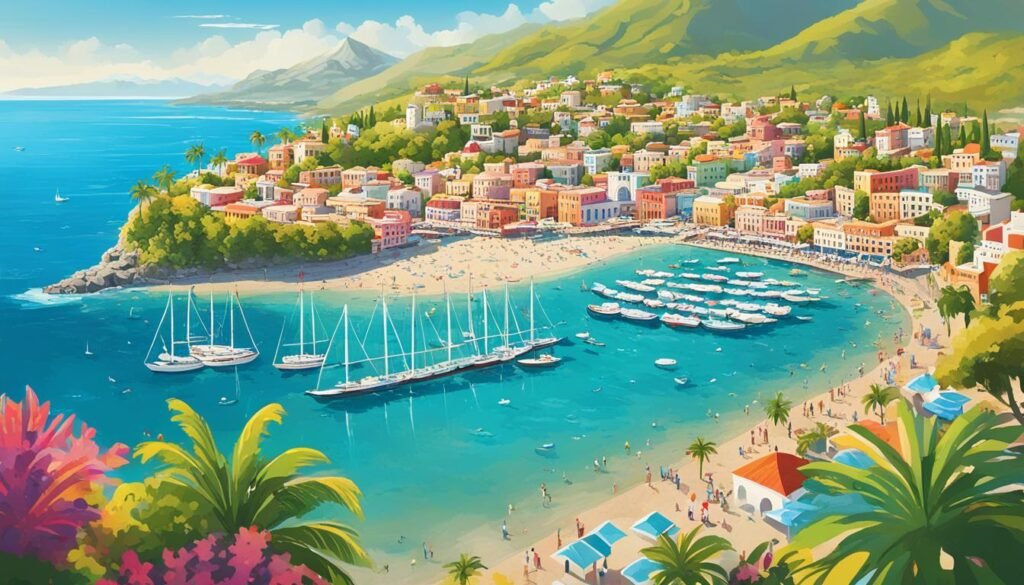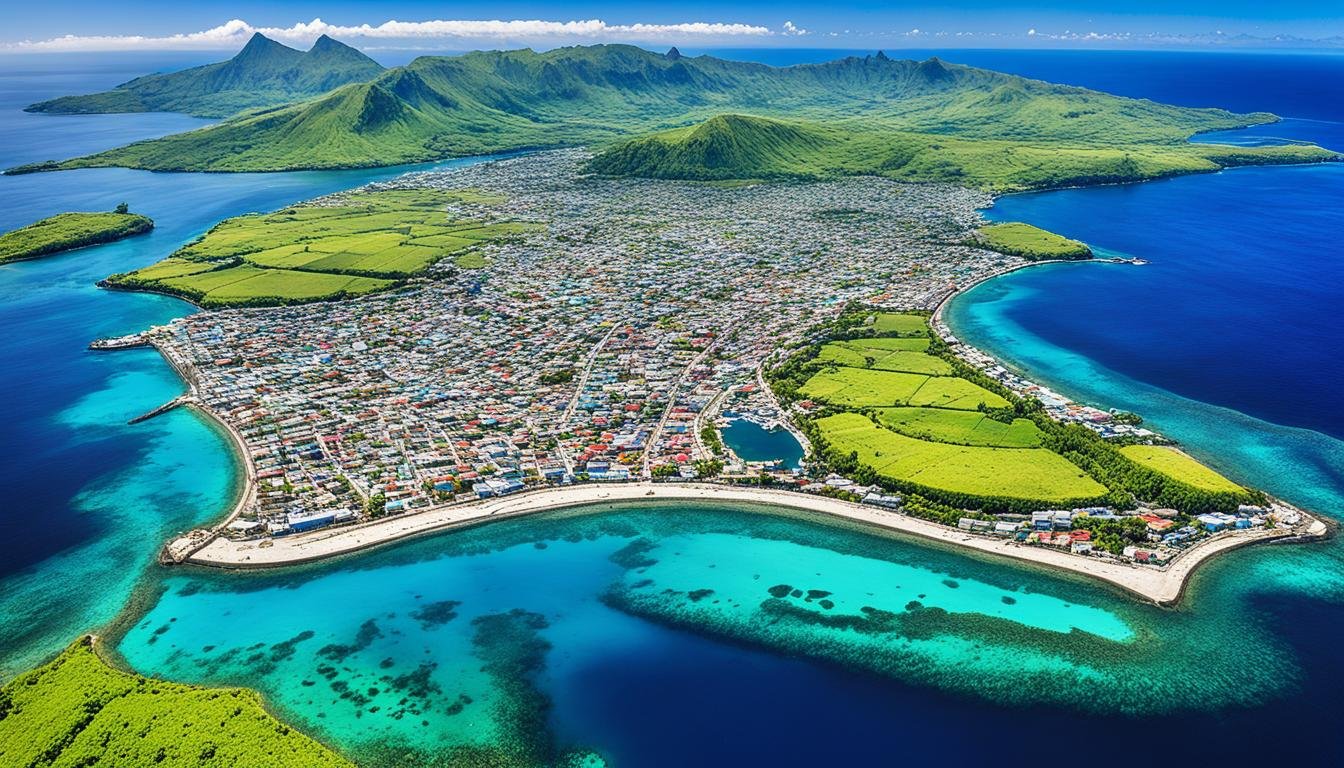Did you know that Moroni, the capital of Comoros, boasts a population of over 41,000 as of 2003, making it the largest settlement in the Comoros archipelago? This coastal city, located on the island of Grande Comore, serves as the administrative and commercial center of the Comoros, a nation situated in the western Indian Ocean. Moroni’s strategic position and its rich history of Arabic and Swahili influences have made it a fascinating subject of study for those interested in the culture and development of the Indian Ocean region.
Key Takeaways
- Moroni is the capital and largest city of Comoros, an archipelago in the western Indian Ocean.
- The city was founded by Arabic-speaking settlers, possibly as early as the 10th century CE, and has a long history of diverse cultural influences.
- Moroni serves as the administrative and commercial center of Comoros, with a population of over 41,000 as of 2003.
- The city’s port exports commodities like vanilla, cocoa, and coffee, and its industries manufacture products such as soft drinks, essential oils, and cement.
- Moroni and the broader Comoros archipelago offer a unique opportunity to study the cultural, historical, and economic dynamics of the Indian Ocean region.
Introduction to the Comoros Archipelago
The Comoros archipelago is a captivating group of volcanic islands nestled in the western Indian Ocean, just off the eastern coast of Africa. This mesmerizing cluster includes the main islands of Grande Comore, Mohéli, Anjouan, and Mayotte, each boasting its own unique character and allure.
Geographic Location and Islands
The Comoros islands emerged from the depths of the Indian Ocean due to volcanic activity, creating a landscape of stunning natural beauty and fragrant plant life. Grande Comore, the largest of the islands, is known for its towering Mount Karthala, an active volcano that dominates the island’s skyline. Mohéli, Anjouan, and Mayotte, the other members of the Comoros archipelago, each offer their own distinct charms, from lush rainforests to pristine beaches.
Historical Background and Influences
The early history of the Comoros islands is shrouded in mystery, but it is believed that Arab and Persian traders first explored the region in antiquity. Over time, the islands were settled by Malayo-Indonesian and Bantu-speaking peoples, and the Shirazi Persians later introduced Sunni Islam as the dominant religion. Sultanates developed lucrative trade relations with other Indian Ocean nations, but the opening of the Suez Canal in the 19th century reduced the Comoros’ importance as a commercial hub. The archipelago eventually came under French colonial rule in the late 19th century, before gaining independence in 1975.

Moroni: The Capital of Comoros
Nestled in the heart of the Comoros archipelago, Moroni stands as the vibrant capital city, boasting a rich history and a rapidly evolving modern landscape. Founded in the 10th century CE, Moroni’s origins can be traced back to its role as the capital of a prosperous sultanate, with deep Swahili cultural influences evident in its language and architecture.
Founding and Development
Moroni’s strategic location along the East African coast allowed it to flourish as a hub of trade and commerce, forging strong ties with the neighboring Swahili City States. Over the centuries, the city evolved, serving as the administrative center of the Comoros Islands until it officially succeeded Dzaoudzi on the island of Mayotte as the capital in 1958, following the country’s independence.
Modern Moroni
Today, Moroni stands as the largest city and economic powerhouse of Comoros, with a population exceeding 41,000 as of 2003. The city’s port remains a vital asset, exporting valuable commodities such as vanilla, cocoa, and coffee, while its industries produce a range of goods, including soft drinks, essential oils, and cement. Despite its modernization, Moroni has retained its architectural charm, with numerous mosques and the pilgrimage center of Chiounda reflecting the city’s deep-rooted Islamic heritage.

Comoros: Indian Ocean Studies Moroni Comoros
The Comoros archipelago and its capital city of Moroni have been the subject of extensive academic and scholarly studies, particularly in the field of Indian Ocean studies. Researchers have investigated the islands’ history, culture, economy, and role in the Indian Ocean trade networks over the centuries. Moroni’s strategic location, diverse influences, and unique blend of African, Arabic, and French elements have made it a focus of interest for scholars examining the region’s geopolitics and sociocultural dynamics.
The Comoros studies have shed light on the islands’ pivotal position in the Indian Ocean, serving as a crossroads for various civilizations and trade routes. Moroni studies have explored the city’s evolution from a small fishing village to an important commercial and administrative center, shaped by the convergence of African, Arab, and European cultures.
Indian Ocean studies have also highlighted the Comoros’ significance in the broader geopolitical and economic landscape of the region. Researchers have analyzed the archipelago’s role in regional trade, its interactions with neighboring countries, and its strategic importance in the maritime sphere. The Comoros’ unique blend of cultural influences and its position at the intersection of major shipping routes have made it a subject of increasing interest for scholars and policymakers alike.

Culture and Traditions of Moroni
Moroni, the capital of Comoros, is a vibrant melting pot of Moroni culture, Swahili culture, Arabic culture, and Comoros culture. The city’s rich heritage is evident in its stunning Moroni architecture, which displays a distinct Arabic aesthetic, and the deeply-rooted Moroni religion that shapes the daily lives of its inhabitants.
Arabic and Swahili Influences
Moroni’s cultural identity has been profoundly shaped by centuries of interaction with the Arab world and the Swahili civilizations of East Africa. The city’s language, customs, and public celebrations reflect the enduring impact of these influential cultures. Residents often observe Islamic holidays and festivals, underscoring the central role of Arabic culture in Moroni.
Architecture and Religion
The architecture of Moroni is a testament to the city’s Arabic heritage, with traditional-style buildings and numerous mosques, such as the iconic Chiounda pilgrimage center. Religion also plays a vital part in Moroni’s cultural identity, as Comoros is an Islamic nation, and the majority of the population practices Sunni Islam, which was introduced by Shirazi Persians.
Economy and Trade in Moroni
As the economic and commercial hub of Comoros, Moroni plays a vital role in the archipelago’s trade and industries. The city’s strategic location and the presence of a thriving port make it a regional center for the export of major agricultural commodities, including vanilla, cocoa, and coffee. Moroni’s industries also contribute significantly to the Comoros economy, with the manufacturing of soft drinks, processed and distilled essential oils, metal and wood products, and cement being key sectors.
Major Exports and Industries
Moroni’s port is the primary export hub for Comoros, handling a vast array of agricultural products. Vanilla, one of the country’s most valuable exports, is shipped globally from the city’s docks. Cocoa and coffee, both grown in the lush interior of the islands, are also important export commodities that pass through Moroni. The city’s industrial base, meanwhile, includes the production of soft drinks, essential oils, and building materials, reflecting its status as a regional trading center.
Moroni’s role as a hub for imports and exports is further underscored by its warehouse facilities, which store a variety of goods, from imported consumer products to petroleum products destined for the wider Comoros market. This diverse economic activity highlights the central position of Moroni within the Comoros economy.

Tourism in Moroni and Comoros
The Comoros archipelago, including the capital city of Moroni, has long been a destination for tourists drawn to the islands’ natural beauty and scenic landscapes. The archipelago’s tropical climate, volcanic landscapes, and miles of pristine beaches have the potential to attract visitors. However, the country’s history of political instability has posed challenges to the development of a thriving Comoros tourism industry.
Despite these challenges, Moroni and the surrounding Comoros islands offer a unique and captivating experience for those seeking to explore the Indian Ocean region. Visitors can immerse themselves in the blend of Arabic, African, and French influences that have shaped the country’s culture and traditions, from the traditional architecture to the vibrant local markets.
The Comoros tourism industry is slowly but steadily gaining traction, with the government and local communities working to promote the archipelago’s natural wonders and cultural heritage. Initiatives to improve infrastructure, enhance security, and develop eco-tourism projects are helping to attract a growing number of adventurous travelers to the Comoros tourism market.
As the Comoros tourism sector continues to evolve, the capital city of Moroni and the surrounding islands are poised to become increasingly popular destinations for those seeking to discover the enchanting beauty of the Indian Ocean. With its rich history, diverse cultural influences, and stunning natural landscapes, the Comoros archipelago offers a truly unique and unforgettable Moroni tourism experience.
Geography and Natural Wonders
The Comoros archipelago, a volcanic island chain in the Indian Ocean, is a land of extraordinary natural beauty. The islands, including the largest, Grande Comore, where the capital Moroni is located, are shaped by their volcanic origins. The highest point in the Comoros is the active volcano of Mount Karthala, rising to an impressive 7,746 feet (2,361 meters) on Grande Comore.
The rugged, mountainous terrain of the Comoros is a testament to the region’s volcanic history. Visitors can witness the dramatic landscapes, including recent lava flows and eroded volcanic features that dot the islands. These volcanic landscapes are a captivating aspect of the Comoros’ natural wonders.
Biodiversity and Endemic Species
Beyond the dramatic volcanic scenery, the Comoros archipelago is home to a remarkable diversity of plant and animal life, much of it found nowhere else on Earth. The islands’ forests and highlands harbor unique species such as lemurs, fruit bats, and the coelacanth – a “living fossil” fish once thought to be extinct for millions of years. However, the expanding human population on the Comoros has put many of these endemic species at risk, threatening their survival.
The Comoros’ rich Comoros biodiversity, including its Comoros endemic species and Comoros wildlife, is a testament to the archipelago’s isolation and evolutionary history. Exploring the Comoros geography and the Karthala volcano on Moroni geography offers visitors a glimpse into the natural wonders that make the Comoros such a unique and captivating destination.
Challenges and Future Prospects
Comoros and its vibrant capital city of Moroni face a range of socioeconomic and political challenges that have hindered the country’s development. The nation’s poor economy, ongoing exodus of educated and skilled workers, political instability, and the threat of natural disasters like volcanic eruptions all present significant obstacles to progress.
Despite these challenges, Comoros and Moroni possess immense potential to capitalize on their unique cultural heritage, natural resources, and strategic location in the Indian Ocean to forge a more prosperous future. By addressing the root causes of the country’s economic and social struggles, Comoros can work towards a more stable and sustainable path forward.
One key area of focus for Comoros’ future development is the strengthening of its economy. Diversifying the country’s exports, investing in infrastructure, and attracting foreign investment could all help to boost economic growth and provide more opportunities for the Comorian people. Additionally, efforts to curb the brain drain and retain talented individuals within the country will be crucial in building a skilled and capable workforce.
As Comoros and Moroni navigate the path ahead, addressing the challenges of political instability and natural disaster preparedness will also be critical. By fostering greater political unity, improving disaster response systems, and leveraging international partnerships, the country can work towards a more secure and resilient future.
Conclusion
The Comoros archipelago and its capital city of Moroni have been the subject of extensive academic and scholarly studies, particularly in the field of Indian Ocean studies. Moroni’s strategic location, diverse cultural influences, and blend of African, Arabic, and French elements have contributed to its significance as a hub of trade and cultural exchange in the region.
While Comoros and Moroni face significant challenges, including economic and political instability, they also possess vast untapped potential for growth and development. Researchers and policymakers continue to explore ways to capitalize on Comoros’ unique geographic position, rich cultural heritage, and natural resources to drive sustainable progress and prosperity for the island nation.
As the Comoros archipelago and Moroni move forward, the insights and knowledge gained through extensive Indian Ocean studies will be crucial in shaping strategies and policies that address the region’s pressing issues, unlock its developmental potential, and strengthen its position in the global community.
Source Links
- Moroni | Comoros, Map, & History – https://www.britannica.com/place/Moroni-Comoros
- Comoros | Culture, History, & People – https://www.britannica.com/place/Comoros
- Moroni, Comoros (10th Century- ) • – https://www.blackpast.org/global-african-history/moroni-comoros-1975/


